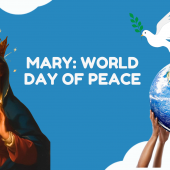I am the Resurrection and the life (John 11,1-45)

“I am the Resurrection and the life” (John 11,1-45)
A. Text:
Now a man was ill, Lazarus from Bethany, the village of Mary and her sister Martha. Mary was the one who had anointed the Lord with perfumed oil and dried his feet with her hair; it was her brother Lazarus who was ill. So the sisters sent word to him, saying, "Master, the one you love is ill." When Jesus heard this he said, "This illness is not to end in death, but is for the glory of God, that the Son of God may be glorified through it."
Now Jesus loved Martha and her sister and Lazarus. So when he heard that he was ill, he remained for two days in the place where he was. Then after this he said to his disciples, "Let us go back to Judea." The disciples said to him, "Rabbi, the Jews were just trying to stone you, and you want to go back there?" Jesus answered, "Are there not twelve hours in a day? If one walks during the day, he does not stumble, because he sees the light of this world. But if one walks at night, he stumbles, because the light is not in him."
He said this, and then told them, "Our friend Lazarus is asleep, but I am going to awaken him." So the disciples said to him, "Master, if he is asleep, he will be saved." But Jesus was talking about his death, while they thought that he meant ordinary sleep. So then Jesus said to them clearly, "Lazarus has died. And I am glad for you that I was not there, that you may believe. Let us go to him." So Thomas, called Didymus, said to his fellow disciples, "Let us also go to die with him." When Jesus arrived, he found that Lazarus had already been in the tomb for four days. Now Bethany was near Jerusalem, only about two miles away. And many of the Jews had come to Martha and Mary to comfort them about their brother.
When Martha heard that Jesus was coming, she went to meet him; but Mary sat at home. Martha said to Jesus, "Lord, if you had been here, my brother would not have died. (But) even now I know that whatever you ask of God, God will give you." Jesus said to her, "Your brother will rise." Martha said to him, "I know he will rise, in the resurrection on the last day." Jesus told her, "I am the resurrection and the life; whoever believes in me, even if he dies, will live, and everyone who lives and believes in me will never die. Do you believe this?" She said to him, "Yes, Lord. I have come to believe that you are the Messiah, the Son of God, the one who is coming into the world." When she had said this, she went and called her sister Mary secretly, saying, "The teacher is here and is asking for you." As soon as she heard this, she rose quickly and went to him. For Jesus had not yet come into the village, but was still where Martha had met him. So when the Jews who were with her in the house comforting her saw Mary get up quickly and go out, they followed her, presuming that she was going to the tomb to weep there. When Mary came to where Jesus was and saw him, she fell at his feet and said to him, "Lord, if you had been here, my brother would not have died." When Jesus saw her weeping and the Jews who had come with her weeping, he became perturbed and deeply troubled, and said, "Where have you laid him?" They said to him, "Sir, come and see." And Jesus wept. So the Jews said, "See how he loved him." But some of them said, "Could not the one who opened the eyes of the blind man have done something so that this man would not have died?"
So Jesus, perturbed again, came to the tomb. It was a cave, and a stone lay across it. Jesus said, "Take away the stone." Martha, the dead man's sister, said to him, "Lord, by now there will be a stench; he has been dead for four days." Jesus said to her, "Did I not tell you that if you believe you will see the glory of God?" So they took away the stone. And Jesus raised his eyes and said, "Father, I thank you for hearing me. I know that you always hear me; but because of the crowd here I have said this, that they may believe that you sent me." And when he had said this, he cried out in a loud voice, "Lazarus, come out!" The dead man came out, tied hand and foot with burial bands, and his face was wrapped in a cloth. So Jesus said to them, "Untie him and let him go." Now many of the Jews who had come to Mary and seen what he had done began to believe in him.
B. Exegesis:
1. On our long Lenten pilgrimage, we witness this Sunday the climax and greatest of Jesus’ signs – the Raising of Lazarus.
What was predicted in figures and metaphors during the days of Ezekiel (Ezekiel 37: First Reading) becomes now real, as Jesus cries out, “Lazarus, come out” and the dead man truly comes out.
This Story of Lazarus, which illustrates that Jesus is the life and the resurrection, has a nexus to Cana, Calvary, Baptism, Eschatology and the Dutch Ceylon.
From Bethany back to Cana:
2. First, there is a fine resemblance between Jesus’ first sign at Cana and His last at Bethany.
i. Both the mother of Jesus at Cana and sisters at Bethany state facts and yet their request is implicit in their words: “They have no wine” at Cana; “Master, the one you love is ill” at Bethany.
ii. Jesus apparently rejects the request in both instances at first: “Woman, how does your concern affect me? My hour has not yet come” at Cana; “This illness is not to end in death …” at Bethany.
iii. The narrative ends in both instances in a miracle that manifests Jesus’ glory for those who believe:
“Jesus did this ... and so revealed his glory, and his disciples began to believe in him” at Cana;
“This illness is not to end in death, but is for the glory of God, that the Son of God may be glorified through it”, “Now many of the Jews ... began to believe in him” at Bethany.
iv. Like the first sign at the end of the week of new creation (1,19 – 2,11), this final sign also takes place on the seventh day.
From Bethany to Calvary:
3. Second, the Story of Lazarus is a preview of what will happen to Jesus, the Paschal Mystery:
i. Ironically Jesus’ gift of life given to Lazarus leads to His own loss of life, as the Sanhedrin seeks to kill Him (11,53).
ii. Paradoxically Jesus cries out “Lazarus, come out” to give life, while His enemies cry out “Crucify him” to end His life.
iii. Just as Lazarus is raised from the dead, Jesus will also be raised from the dead.
iv. Lazarus comes forth with his burial garments for he will need them again when he dies.
But Jesus will leave His garments behind in the tomb on that first Easter Sunday. He won’t need them any longer, as His Resurrection marks the death of death.
From Bethany to Baptism:
4. Third, the Story of Lazarus is related not only to Cana and Calvary but also to our Sacred Baptism.
As in the Story of Lazarus, so at Baptism Christ raises us from death in sin to a new life in the Spirit. We, the exiles in the captivity of sin, are restored and settled in the Land of God (Ezekiel 37).
From Bethany to Eschatology:
5. The Story of Lazarus is connected to our Eschatology as well. The raising of Lazarus is a sign. Hence Lazarus is not only an historical figure but also a symbol in John. He represents every believer like us who loves Jesus and is loved by Him and whom the Lord will raise up on the last day. Lazarus is a token of the real life that Jesus dead and raised will give to all who believe in Him.
In the language of St. Paul, “If the Spirit of the one who raised Jesus from the dead dwells in you, the one who raised Christ from the dead will give life to your mortal bodies also, through his Spirit that dwells in you” (Romans 8: Second Reading).
C. Application:
6. The Story of Lazarus can be linked to the historical vicissitudes of the Church. What happened at Bethany of Israel is taking place in many parts of the world today.
Christians face persecutions and death in many parts of Asia and world at large. Just as the fatal illness of Lazarus served not death but God’s glory, these shall be occasion to confirm the true faith of the believers in Christ.
Just as Jesus raised Lazarus, who was dead for four days with no hope of resuscitation, by his command, may He help us today to become a truly living and evangelizing Church in Asia.
Radio Veritas Asia (RVA), a media platform of the Catholic Church, aims to share Christ. RVA started in 1969 as a continental Catholic radio station to serve Asian countries in their respective local language, thus earning the tag “the Voice of Asian Christianity.” Responding to the emerging context, RVA embraced media platforms to connect with the global Asian audience via its 21 language websites and various social media platforms.











